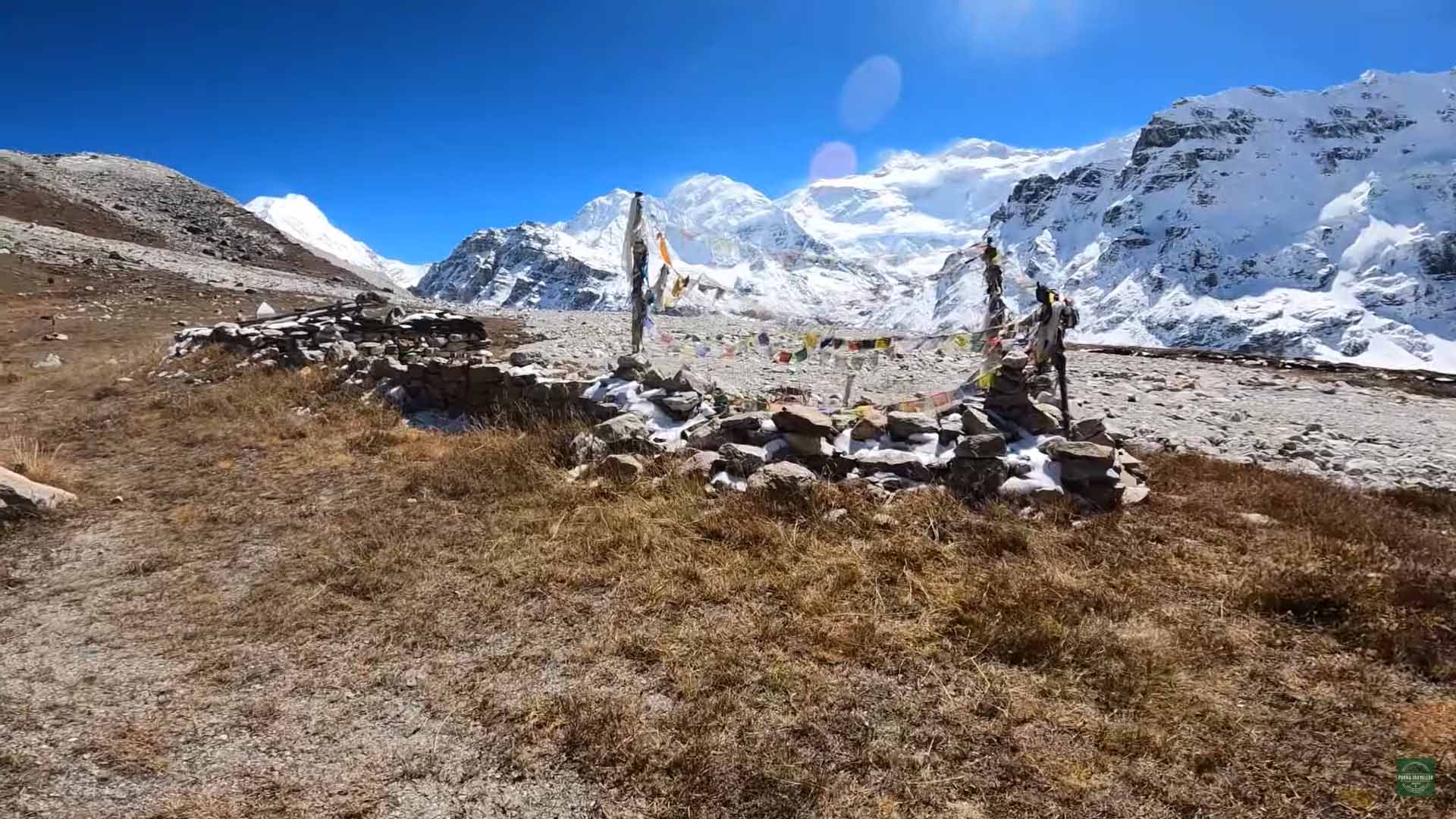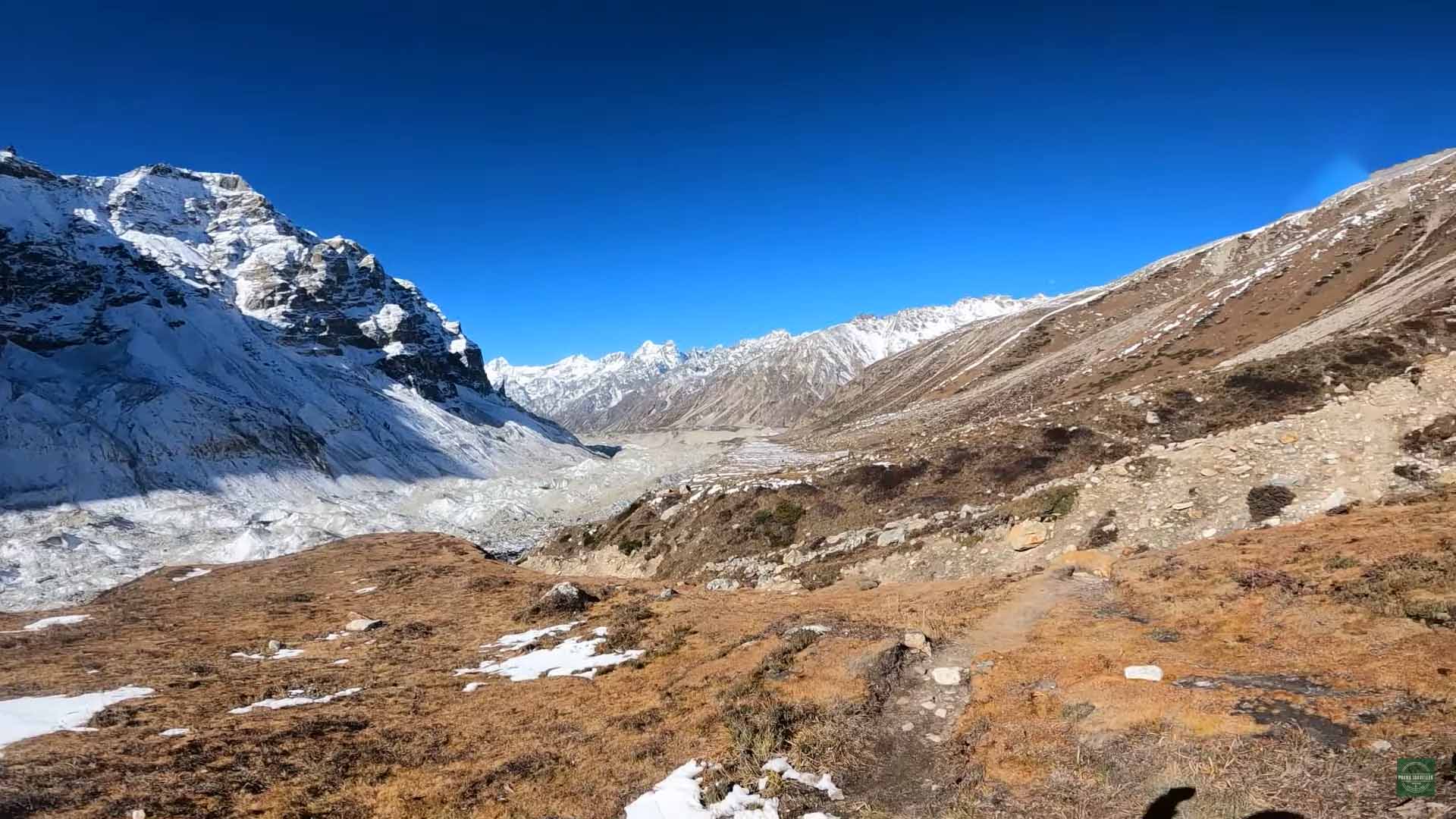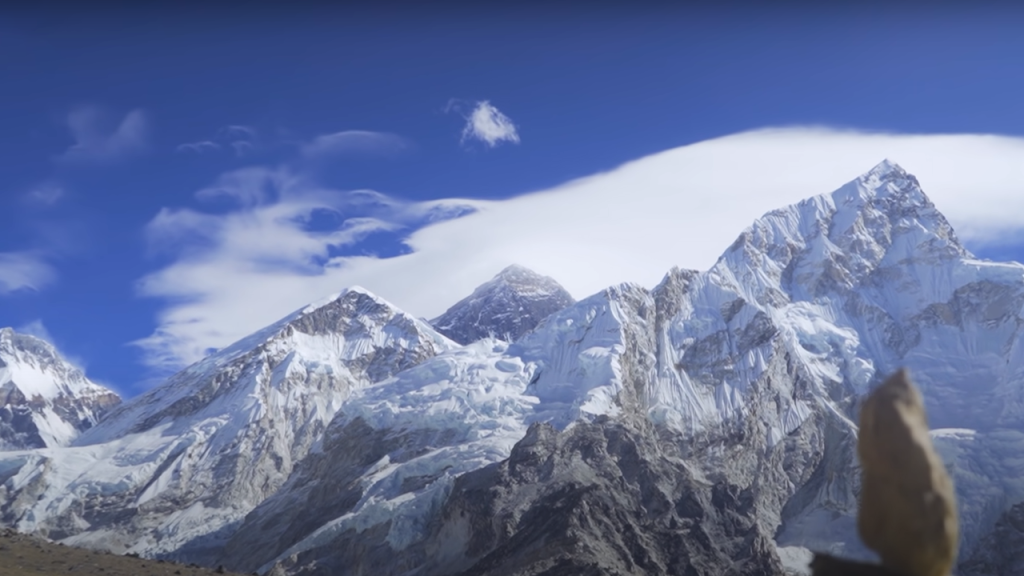Kanchenjunga 8586metres
Kanchenjunga holds great religious significance to the Nepalese and Sikkimese people who live within its shadow and to whom the mountain is the symbolic residence of a god.

‘The Five Treasures of the Great Snow’ as the name Kanchenjunga loosely translated from the Tibetan refers to the five great glaciers that originate high up on the slopes of this great mountain massif.
Until 1847, when with the use of scientific instruments, Everest’s height was first confirmed Kanchenjunga was believed to be the highest mountain in the world. Unlike Everest which is almost obscured from view until you get to within proximity, Kanchenjunga’s enormous mass stands relatively isolated and is visibly separated from its neighbors and so from the outset, its height and bulk presented the true character of being the highest mountain on earth.
From the earliest times when the British first colonized India Kanchenjunga was recognized as a sacred mountain and the abode of the gods. Being visible on a good day the line of the summit ridge, like a fine spider’s silk thread, glistens in the morning light attracting the attention of artists, poets, and writers alike all of whom visited the British Hill Station in Darjeeling.
Joseph Hooker, the great botanist, visited the area in 1848-1849 to study and collect new plant species and to carry out observations and experiments on behalf of Charles Darwin. In 1899 Sir Douglas Freshfield led an expedition to the area that then circumnavigated Kanchenjunga.
On the first ascent, as a sign of respect to the gods, George Band and Joe Brown stopped a few feet short of the summit.
Reference – ‘Kanchenjunga’ Imaging a Himalayan Mountain; Simon Pierse 2005
Trekking in the Kanchenjunga area is a great wilderness experience in amongst the valleys and lesser satellite peaks of one of the world’s most spectacular mountains, the queen of the mountains that sits on Nepal’s border with Sikkim and Tibet. Traveling around Kanchenjunga, the third highest peak in the world, you pass through wide and varied ecological zones, from subtropical land to glacial wilderness. Surrounding the Kanchenjunga massif are many other smaller but never-the-less, spectacular peaks, many of which have never been climbed.

The area is the home of the Rai and Limbu people; there are Tibetan Buddhist villages and a mosaic of other Nepali cultures and ethnic groups, the Sherpa who have a different culture and tradition from those of Solukhumbu district, Rai, Chhetri, and Brahman now all live in the Kanchenjunga region. There is also a rich diversity of wildlife, animals including the snow leopard, Himalayan black bear, musk deer, and red panda, and the birds, the Impheyan, pheasant, red-billed blue magpie, and the shy drongo are the major birds found there.
Any trek into the Kanchenjunga area requires at least three days of traveling time.
For those who wish to complete the Great Himalayan Trail, either in sections or as one complete expedition, the tremendous route starts with part of this trek. There are other less serious and demanding treks in this area with stunning views of Kanchenjunga, however, they are all remote.
Kanchenjunga Base Camp Trek
Eastern Nepal, from the earliest times, held a fascination for explorers, as a mountain seen from the old British Hill station in Darjeeling it was always a magnet for those interested in the study of ethnic groups, flora, fauna, and some of the most outstanding mountain scenery anywhere in the Himalaya.

However, the western side of Kanchenjunga was closed to trekkers until 1988 by which time most attention was focused on Everest and Annapurna. Today this trek receives less attention but by following the glacial Tamur and Ghunsa Rivers to their source on the northwest side of the Kanchenjunga a rich environment of alpine magnificence can be seen in almost every direction dominated by the peaks of Pyramid Peak, Jannu, the Twins and Kanchenjunga 8586m. On crossing the Mirgin La Pass 4500m another vista of magnificent peaks opens up to the southeast.

Trip Highlights
Region: Kanchenjunga Region of Nepal
Grade: Grade 5
Time: Minimum recommended days 23 trekking
Height: Maximum 5140m however, on this remote trek there are several continuous days spent above 4000m
Style: Camping
Conquering Kanchenjunga: A 23-Day Camping Expedition in Nepal’s Eastern Wonderland
Dive into the heart of the Kanchenjunga region on this challenging yet rewarding 23-day expedition. Trek through diverse landscapes, from lush valleys to dramatic glaciers, culminating in breathtaking views of the world’s third-highest peak.
Itinerary:
Day 1: Arrive in Kathmandu, the capital of Nepal. You will be met at the airport and transferred to your hotel.
Day 2: Spend the day exploring Kathmandu. Visit the temples, palaces, and gardens of this ancient city. In the afternoon, you will have a meeting with your guide to discuss the trek and get fitted for your rental equipment.
Day 3: Fly to Biratnagar, the second-largest city in Nepal. From there, you will take a smaller plane to Suketar, the gateway to the Kanchenjunga region. In the afternoon, you will begin your trek to Phurmbu, a small village at an altitude of 1,800 meters.
Day 4: Trek to Chirwa, a village at an altitude of 1,270 meters. The trail follows the Tamur River and offers stunning views of the Himalayas.
Day 5: Trek to Sakathum, a village at an altitude of 1,660 meters. The trail passes through rhododendron forests and offers glimpses of Mount Kanchenjunga.
Day 6: Trek to Amjilosa, a village at an altitude of 2,510 meters. The trail is steep and challenging, but the views are worth it.
Day 7: Trek to Gyaplat, a village at an altitude of 2,730 meters. The trail is mostly flat and offers views of the Himalayas.
Day 8: Trek to Ghunsa, a village at an altitude of 3,595 meters. This is the largest village in the Kanchenjunga region and will be your base for the next few days.
Day 9: Rest and acclimatization day in Ghunsa. It is important to take rest days at higher altitudes to allow your body to adjust to the thinner air.
Day 10: Trek to Khambachen, a village at an altitude of 4,099 meters. The trail is steep and challenging, but the views of the Himalayas are even better.
Day 11: Trek to Lhonak, a village at an altitude of 4,785 meters. This is the highest village on the trek and offers stunning views of Mount Kanchenjunga.
Day 12: Rest and acclimatization day in Lhonak. It is important to take rest days at higher altitudes to allow your body to adjust to the thinner air.
Day 13: Trek to Pangpema Base Camp, the base camp for the north face of Mount Kanchenjunga. The base camp is located at an altitude of 5,143 meters.
Day 14: Trek back to Khambachen.
Day 15: Trek back to Ghunsa.
Day 16: Trek to Sele La, a pass at an altitude of 4,290 meters. The pass offers stunning views of the Himalayas.
Day 17: Trek to Cheram, a village at an altitude of 3,870 meters.
Day 18: Trek to Tortong, a village at an altitude of 2,995 meters.
Day 19: Trek to Yamphudin, a village at an altitude of 2,080 meters.
Day 20: Trek to Mamangkhe, a village at an altitude of 1,920 meters.
Day 21: Trek to Khesewa, a village at an altitude of 2,120 meters.
Day 22: Trek to Lalikharka, a village at an altitude of 2,276 meters.
Day 23: Trek to Suketart, a village at an altitude of 2,300 meters.
Day 24: Fly back to Biratnagar and onto Kathmandu.
Day 25: Depart Kathmandu.
This is a challenging trek, but it is also an incredibly rewarding one. The views of the Himalayas are simply breathtaking, and you will have the opportunity to experience the culture of



